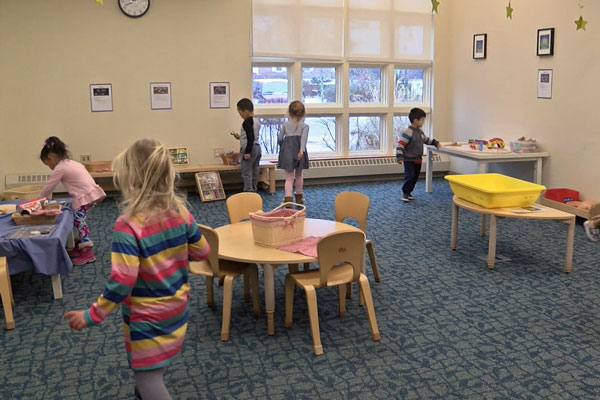The TIMPANI Toy Museum
(This video has captions. You can turn them on by clicking the CC icon at the bottom of the video.)
Download a printable transcript.
Child: Hey, look it!
Teacher: Oh, what happened?
Today is… The TIMPANI Toy Museum (0:19)
Teacher: You can choose whatever center you want.
Child: Wow!
Ashley Anderson, Toy Museum Architect, Center for Early Childhood Education: This morning we’re celebrating the tenth year of the TIMPANI Toy Study, which is a study that’s gone on at Eastern for ten years, exploring high quality toys for children in a preschool environment.
Terry Surprenant, Toy Museum Architect, Center for Early Childhood Education: We’ve collected together thirty of the top scoring toys, and we’ve put them on display to create a little interactive museum for children and families.
Niloufar Rezai, Director, Child and Family Development Resource Center: Each station has those toys featured with a little description of what the toy did best for children and why it did those things. So during the course of the week, children have been coming to visit the toy museum. Their families have been coming with them to visit the toy museum.
Jazzabelle Pluss, Student Worker: They get really excited to come out here cause, okay, we have all the toys in the classroom, but it’s nice to come out and find new different things to play with and see how they all interact differently with them all.
Child: We’re going to the playground, Annabelle! Wheee!
Terry Surprenant: I think it’s really interesting to have a variety of quality toys all in the same place and co-located. I think it was really interesting for kids to see some of these toys that they’ve used in the past but in a new setting.
Ashley Anderson: There was ample opportunities for building, for playing together, social interactions.
Ashley: How many do you have in this one?
Child: One. Two.
Ashley: Two!
Jazzabelle Pluss: They also interact with each other a little bit differently out here, and they work together a lot out here compared to sometimes they work differently in the classroom.
Child: I need help for my birthday party!
Child 2: Okay, Mommy’s gonna help you.
Terry Surprenant: It kind of brings toys to life, and I think that’s something we can learn from. Even in homes when kids get kind of bored with the toys that they’ve been playing with, sometimes putting them away for a while and taking them back out, or even displaying them in a different place can really make it seem novel and kind of re-ignite their interest in them.
Child: That was fun!
Teacher: Yeah, that was so much fun.
Child: I remember that one.
Teacher: You did. I liked those toys.



